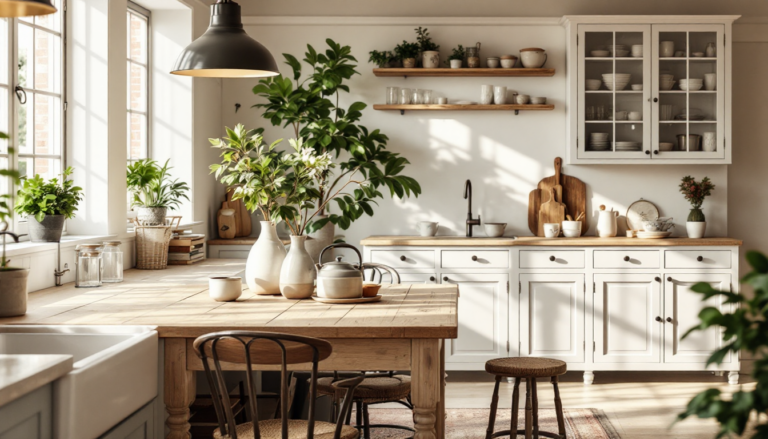Argomenti trattati
The farmhouse kitchen aesthetic has come a long way over the years, evolving from its humble origins into a style that many homeowners now adore. After all, the kitchen is often considered the heart of the home; it should radiate warmth and comfort. And let’s be honest—who doesn’t love that cozy vibe? The beauty of farmhouse design lies in its adaptability, blending modern twists with classic European influences. Whether you’re a traditionalist or leaning towards a contemporary flair, there are countless ways to infuse your kitchen with farmhouse charm. Ready to explore? Let’s dive in!
The Historical Journey of Farmhouse Design
Originally, the farmhouse style was all about practicality, designed to meet the needs of farmers toiling in the fields. Unlike the ornate features of Victorian or Colonial designs, farmhouse aesthetics focused on functionality. Think Dutch doors, spacious porches, and large fireplaces that not only provided warmth but also served as gathering spots for families.
As industrialization rolled in, the farmhouse look began to evolve. While it retained those practical elements, decorative features started to make their way in. The kitchen, a central hub for family interaction, embraced these changes beautifully. Now we see painted shiplap, custom cabinetry, and charming pantry doors adding to its inviting allure.
Fast forward to today, and the farmhouse kitchen aesthetic is a delightful blend of tradition and innovation. Designers are reimagining classic elements to resonate with modern sensibilities, striking a balance between rustic charm and contemporary comforts. The goal? To keep the space functional while ensuring it’s also visually appealing. Isn’t it fascinating how styles can evolve yet still maintain their core essence?
Inspiring Farmhouse Kitchen Ideas
If you’re dreaming of a farmhouse kitchen, there’s no shortage of ideas to inspire you. One popular approach is to use natural materials like reclaimed wood beams and shiplap, which can instantly inject warmth and character into your space. For instance, a designer recently showcased a project where they left exposed wooden beams bare to highlight their rustic charm, beautifully contrasting with a lighter color palette. This combination not only enhances the farmhouse vibe but also helps define different areas in open-plan layouts. How cool is that?
Another captivating idea is to opt for open shelving instead of traditional cabinetry. This design choice lets you display your favorite dishes, decorative pieces, and seasonal decor, adding a personal touch to your kitchen. An interior designer recently achieved this by installing open shelves against a decorative wall covering, creating both visual interest and practical storage. Who wouldn’t love to show off their favorite items?
Let’s not forget about color, which plays a vital role in establishing the farmhouse aesthetic. While neutral tones are often preferred, introducing pops of color can add a playful twist. Picture a vibrant yellow kitchen paired with rustic elements like pewter hardware—talk about a cheerful and welcoming atmosphere! This approach shows that farmhouse design can be both whimsical and stylish, engaging the senses while promoting a sense of comfort. Doesn’t that sound inviting?
Implementing Farmhouse Elements in Your Kitchen
Ready to transform your kitchen into a farmhouse haven? Start by assessing your space and identifying which elements resonate with you. Consider a neutral base, like white or soft pastel shades, to set the stage for vibrant accents and decor. From there, think about incorporating vintage-inspired fixtures and materials that harken back to traditional farmhouse designs.
Don’t underestimate the charm of antique or vintage pieces! For example, pairing a classic farmhouse sink with modern appliances can create a stunning visual contrast, blending old-world charm with contemporary functionality. Plus, displaying antique cookware or heirloom pieces on open shelves can serve as both decor and conversation starters. Can you imagine the stories those items could tell?
Finally, lighting is essential. Choosing fixtures that reflect a farmhouse aesthetic, such as wrought iron or vintage-inspired pendant lights, can further enhance the ambiance. Good lighting not only accentuates key design elements but also creates a warm and inviting atmosphere that draws family and friends together. What’s not to love about that?
Key Performance Indicators for Your Farmhouse Kitchen Project
As you embark on your farmhouse kitchen transformation, it’s crucial to monitor certain key performance indicators (KPIs) to gauge the project’s success. Start by evaluating how the changes impact the overall functionality of the space. Are you navigating the kitchen more easily? Are the new elements enhancing your cooking and entertaining experience?
Also, pay attention to how your family interacts within the space. A well-designed kitchen should foster communication and connection, so consider whether the layout encourages gathering and interaction. Lastly, assess your aesthetic satisfaction—does the design reflect your personal style and make you feel at home? These questions are essential for creating a kitchen that not only looks beautiful but serves as a practical, welcoming hub for your family and friends.

